Management Accounting Methods and Reporting at Dell Corp
VerifiedAdded on 2020/02/12
|19
|4602
|114
Report
AI Summary
This report provides a comprehensive overview of management accounting, focusing on its application within Dell Corporation. It begins by defining management accounting and differentiating it from financial accounting, highlighting its role in aiding management decision-making. The report then delves into various management accounting systems, including cost accounting, job ordering, contract costing, and process costing. It explores different reporting methods, such as budget reports, accounts receivable aging reports, job cost reporting, and inventory and manufacturing reports. Furthermore, the report analyzes marginal and absorption costing methods, demonstrating their application through calculations. The content covers the benefits of management accounting systems and their integration with organizational processes. The report concludes with a summary of the key findings and their implications for Dell Corporation.
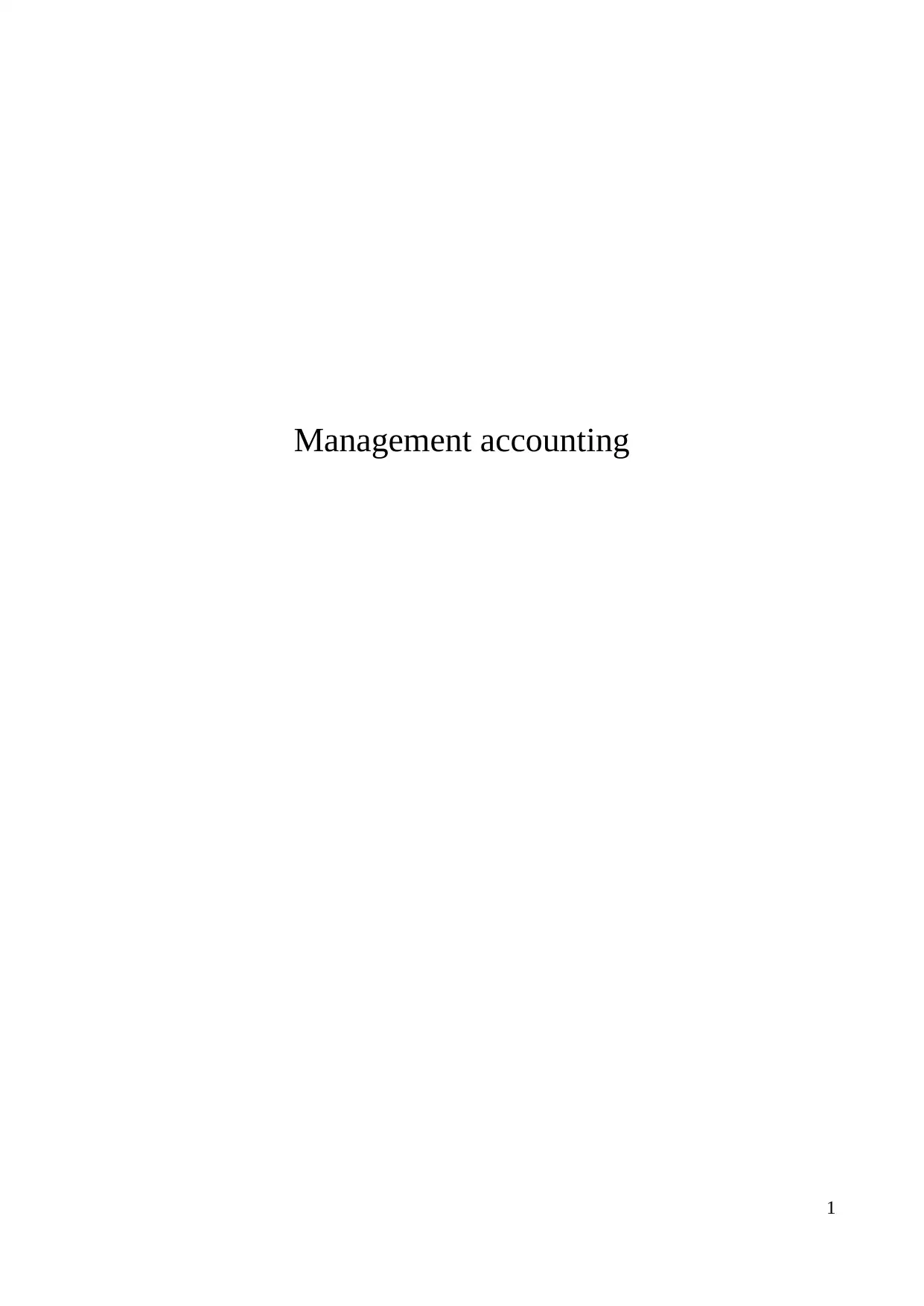
Management accounting
1
1
Paraphrase This Document
Need a fresh take? Get an instant paraphrase of this document with our AI Paraphraser
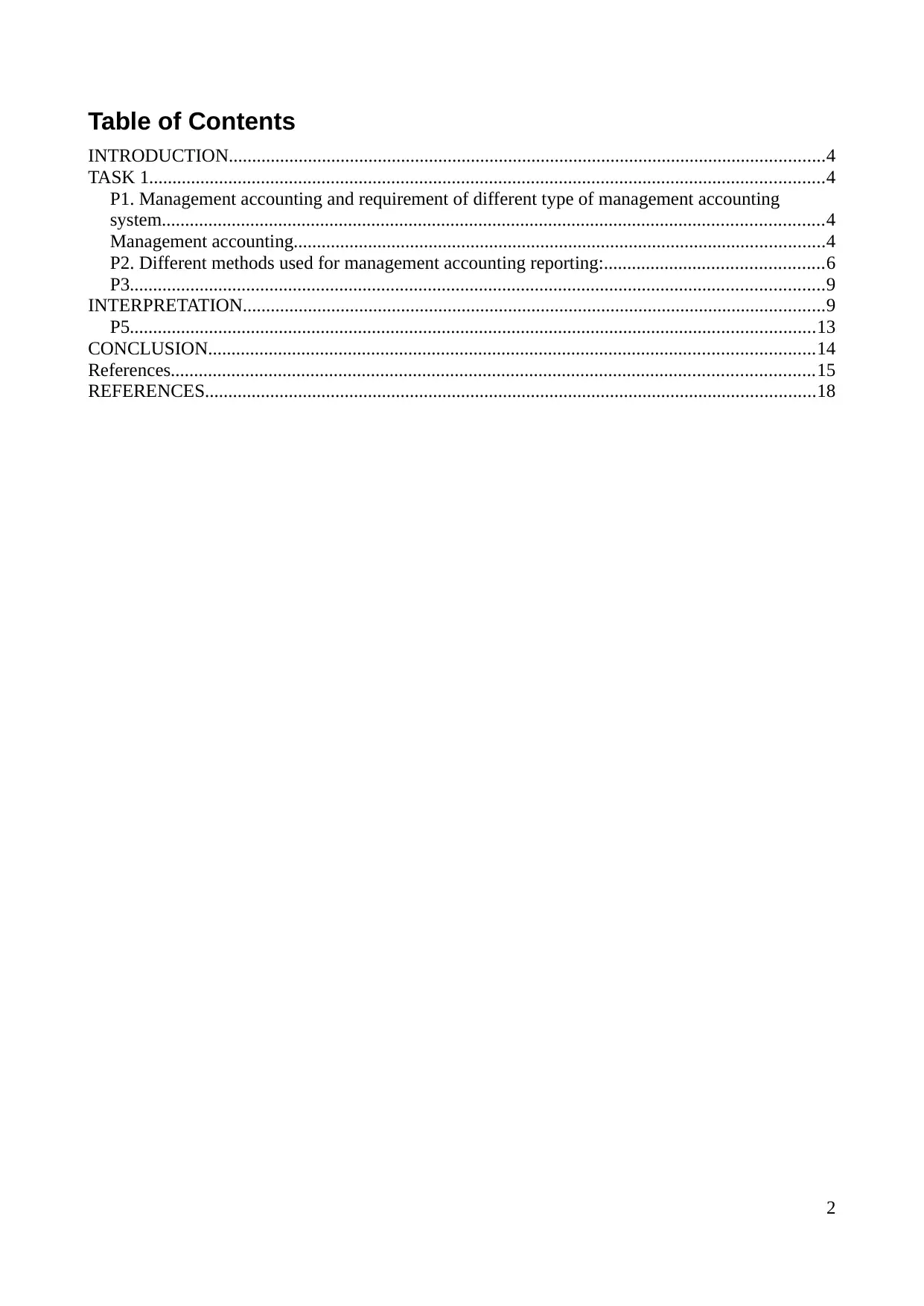
Table of Contents
INTRODUCTION................................................................................................................................4
TASK 1.................................................................................................................................................4
P1. Management accounting and requirement of different type of management accounting
system..............................................................................................................................................4
Management accounting..................................................................................................................4
P2. Different methods used for management accounting reporting:...............................................6
P3.....................................................................................................................................................9
INTERPRETATION.............................................................................................................................9
P5...................................................................................................................................................13
CONCLUSION..................................................................................................................................14
References..........................................................................................................................................15
REFERENCES...................................................................................................................................18
2
INTRODUCTION................................................................................................................................4
TASK 1.................................................................................................................................................4
P1. Management accounting and requirement of different type of management accounting
system..............................................................................................................................................4
Management accounting..................................................................................................................4
P2. Different methods used for management accounting reporting:...............................................6
P3.....................................................................................................................................................9
INTERPRETATION.............................................................................................................................9
P5...................................................................................................................................................13
CONCLUSION..................................................................................................................................14
References..........................................................................................................................................15
REFERENCES...................................................................................................................................18
2

3
⊘ This is a preview!⊘
Do you want full access?
Subscribe today to unlock all pages.

Trusted by 1+ million students worldwide
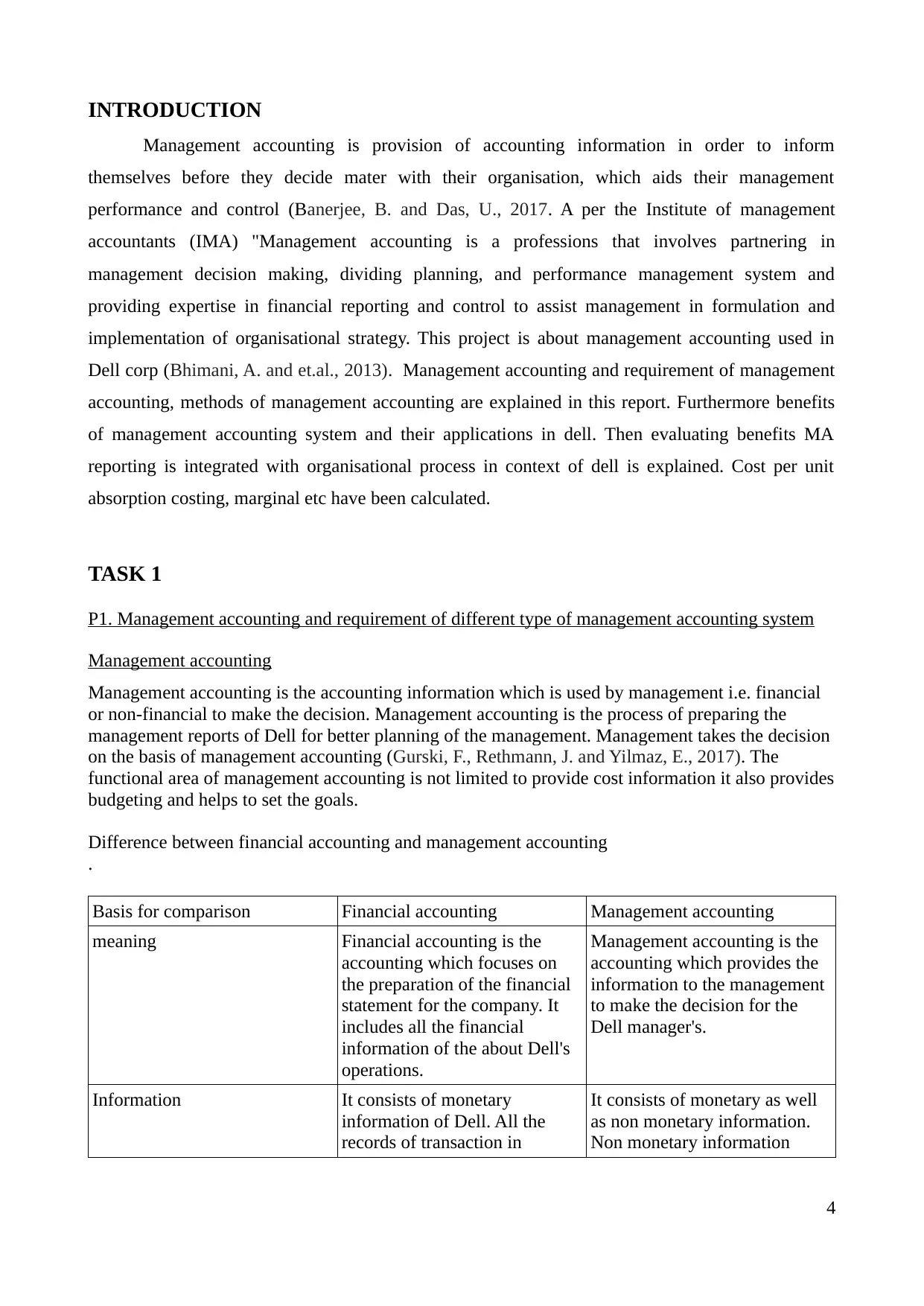
INTRODUCTION
Management accounting is provision of accounting information in order to inform
themselves before they decide mater with their organisation, which aids their management
performance and control (Banerjee, B. and Das, U., 2017. A per the Institute of management
accountants (IMA) "Management accounting is a professions that involves partnering in
management decision making, dividing planning, and performance management system and
providing expertise in financial reporting and control to assist management in formulation and
implementation of organisational strategy. This project is about management accounting used in
Dell corp (Bhimani, A. and et.al., 2013). Management accounting and requirement of management
accounting, methods of management accounting are explained in this report. Furthermore benefits
of management accounting system and their applications in dell. Then evaluating benefits MA
reporting is integrated with organisational process in context of dell is explained. Cost per unit
absorption costing, marginal etc have been calculated.
TASK 1
P1. Management accounting and requirement of different type of management accounting system
Management accounting
Management accounting is the accounting information which is used by management i.e. financial
or non-financial to make the decision. Management accounting is the process of preparing the
management reports of Dell for better planning of the management. Management takes the decision
on the basis of management accounting (Gurski, F., Rethmann, J. and Yilmaz, E., 2017). The
functional area of management accounting is not limited to provide cost information it also provides
budgeting and helps to set the goals.
Difference between financial accounting and management accounting
.
Basis for comparison Financial accounting Management accounting
meaning Financial accounting is the
accounting which focuses on
the preparation of the financial
statement for the company. It
includes all the financial
information of the about Dell's
operations.
Management accounting is the
accounting which provides the
information to the management
to make the decision for the
Dell manager's.
Information It consists of monetary
information of Dell. All the
records of transaction in
It consists of monetary as well
as non monetary information.
Non monetary information
4
Management accounting is provision of accounting information in order to inform
themselves before they decide mater with their organisation, which aids their management
performance and control (Banerjee, B. and Das, U., 2017. A per the Institute of management
accountants (IMA) "Management accounting is a professions that involves partnering in
management decision making, dividing planning, and performance management system and
providing expertise in financial reporting and control to assist management in formulation and
implementation of organisational strategy. This project is about management accounting used in
Dell corp (Bhimani, A. and et.al., 2013). Management accounting and requirement of management
accounting, methods of management accounting are explained in this report. Furthermore benefits
of management accounting system and their applications in dell. Then evaluating benefits MA
reporting is integrated with organisational process in context of dell is explained. Cost per unit
absorption costing, marginal etc have been calculated.
TASK 1
P1. Management accounting and requirement of different type of management accounting system
Management accounting
Management accounting is the accounting information which is used by management i.e. financial
or non-financial to make the decision. Management accounting is the process of preparing the
management reports of Dell for better planning of the management. Management takes the decision
on the basis of management accounting (Gurski, F., Rethmann, J. and Yilmaz, E., 2017). The
functional area of management accounting is not limited to provide cost information it also provides
budgeting and helps to set the goals.
Difference between financial accounting and management accounting
.
Basis for comparison Financial accounting Management accounting
meaning Financial accounting is the
accounting which focuses on
the preparation of the financial
statement for the company. It
includes all the financial
information of the about Dell's
operations.
Management accounting is the
accounting which provides the
information to the management
to make the decision for the
Dell manager's.
Information It consists of monetary
information of Dell. All the
records of transaction in
It consists of monetary as well
as non monetary information.
Non monetary information
4
Paraphrase This Document
Need a fresh take? Get an instant paraphrase of this document with our AI Paraphraser
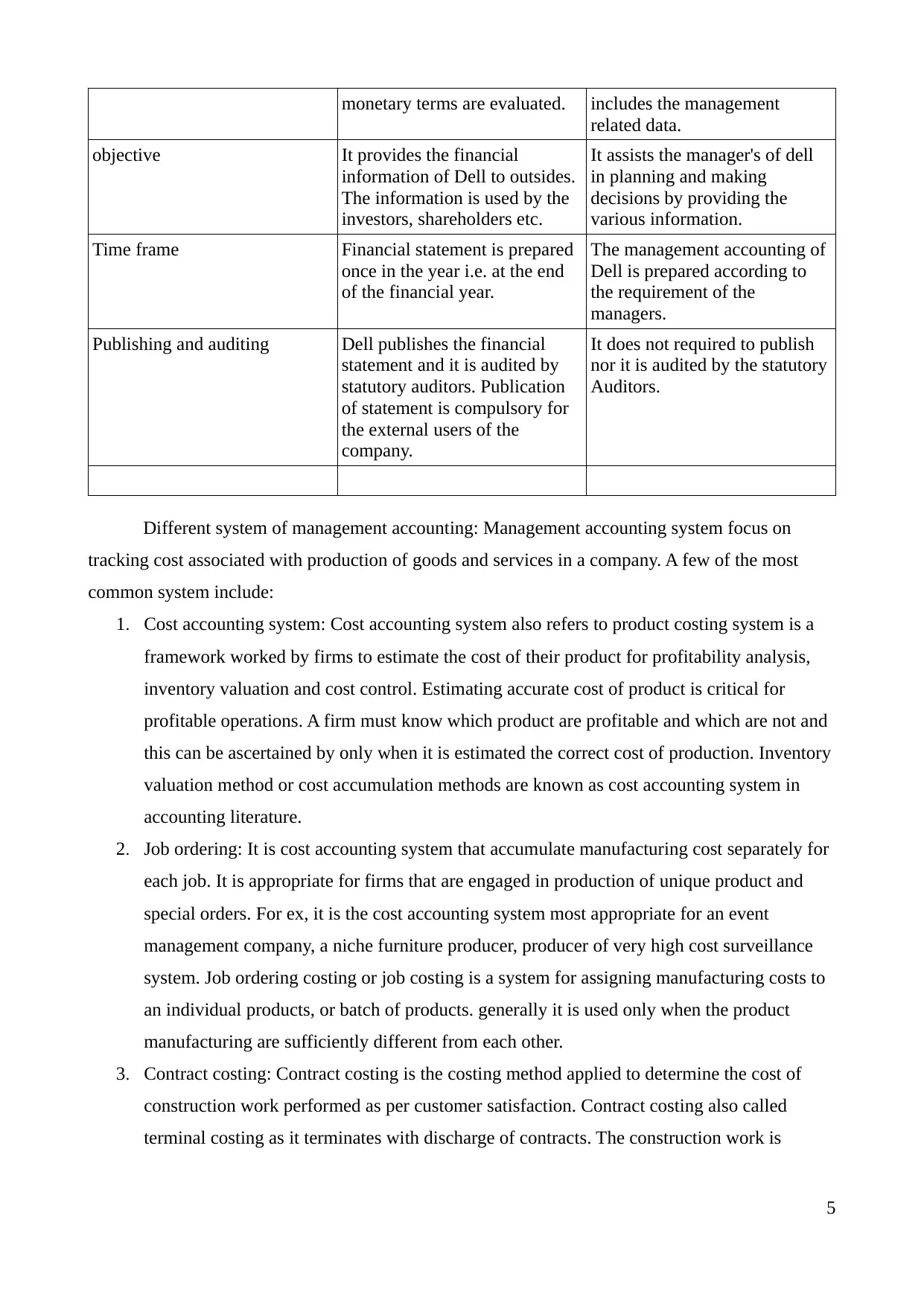
monetary terms are evaluated. includes the management
related data.
objective It provides the financial
information of Dell to outsides.
The information is used by the
investors, shareholders etc.
It assists the manager's of dell
in planning and making
decisions by providing the
various information.
Time frame Financial statement is prepared
once in the year i.e. at the end
of the financial year.
The management accounting of
Dell is prepared according to
the requirement of the
managers.
Publishing and auditing Dell publishes the financial
statement and it is audited by
statutory auditors. Publication
of statement is compulsory for
the external users of the
company.
It does not required to publish
nor it is audited by the statutory
Auditors.
Different system of management accounting: Management accounting system focus on
tracking cost associated with production of goods and services in a company. A few of the most
common system include:
1. Cost accounting system: Cost accounting system also refers to product costing system is a
framework worked by firms to estimate the cost of their product for profitability analysis,
inventory valuation and cost control. Estimating accurate cost of product is critical for
profitable operations. A firm must know which product are profitable and which are not and
this can be ascertained by only when it is estimated the correct cost of production. Inventory
valuation method or cost accumulation methods are known as cost accounting system in
accounting literature.
2. Job ordering: It is cost accounting system that accumulate manufacturing cost separately for
each job. It is appropriate for firms that are engaged in production of unique product and
special orders. For ex, it is the cost accounting system most appropriate for an event
management company, a niche furniture producer, producer of very high cost surveillance
system. Job ordering costing or job costing is a system for assigning manufacturing costs to
an individual products, or batch of products. generally it is used only when the product
manufacturing are sufficiently different from each other.
3. Contract costing: Contract costing is the costing method applied to determine the cost of
construction work performed as per customer satisfaction. Contract costing also called
terminal costing as it terminates with discharge of contracts. The construction work is
5
related data.
objective It provides the financial
information of Dell to outsides.
The information is used by the
investors, shareholders etc.
It assists the manager's of dell
in planning and making
decisions by providing the
various information.
Time frame Financial statement is prepared
once in the year i.e. at the end
of the financial year.
The management accounting of
Dell is prepared according to
the requirement of the
managers.
Publishing and auditing Dell publishes the financial
statement and it is audited by
statutory auditors. Publication
of statement is compulsory for
the external users of the
company.
It does not required to publish
nor it is audited by the statutory
Auditors.
Different system of management accounting: Management accounting system focus on
tracking cost associated with production of goods and services in a company. A few of the most
common system include:
1. Cost accounting system: Cost accounting system also refers to product costing system is a
framework worked by firms to estimate the cost of their product for profitability analysis,
inventory valuation and cost control. Estimating accurate cost of product is critical for
profitable operations. A firm must know which product are profitable and which are not and
this can be ascertained by only when it is estimated the correct cost of production. Inventory
valuation method or cost accumulation methods are known as cost accounting system in
accounting literature.
2. Job ordering: It is cost accounting system that accumulate manufacturing cost separately for
each job. It is appropriate for firms that are engaged in production of unique product and
special orders. For ex, it is the cost accounting system most appropriate for an event
management company, a niche furniture producer, producer of very high cost surveillance
system. Job ordering costing or job costing is a system for assigning manufacturing costs to
an individual products, or batch of products. generally it is used only when the product
manufacturing are sufficiently different from each other.
3. Contract costing: Contract costing is the costing method applied to determine the cost of
construction work performed as per customer satisfaction. Contract costing also called
terminal costing as it terminates with discharge of contracts. The construction work is
5
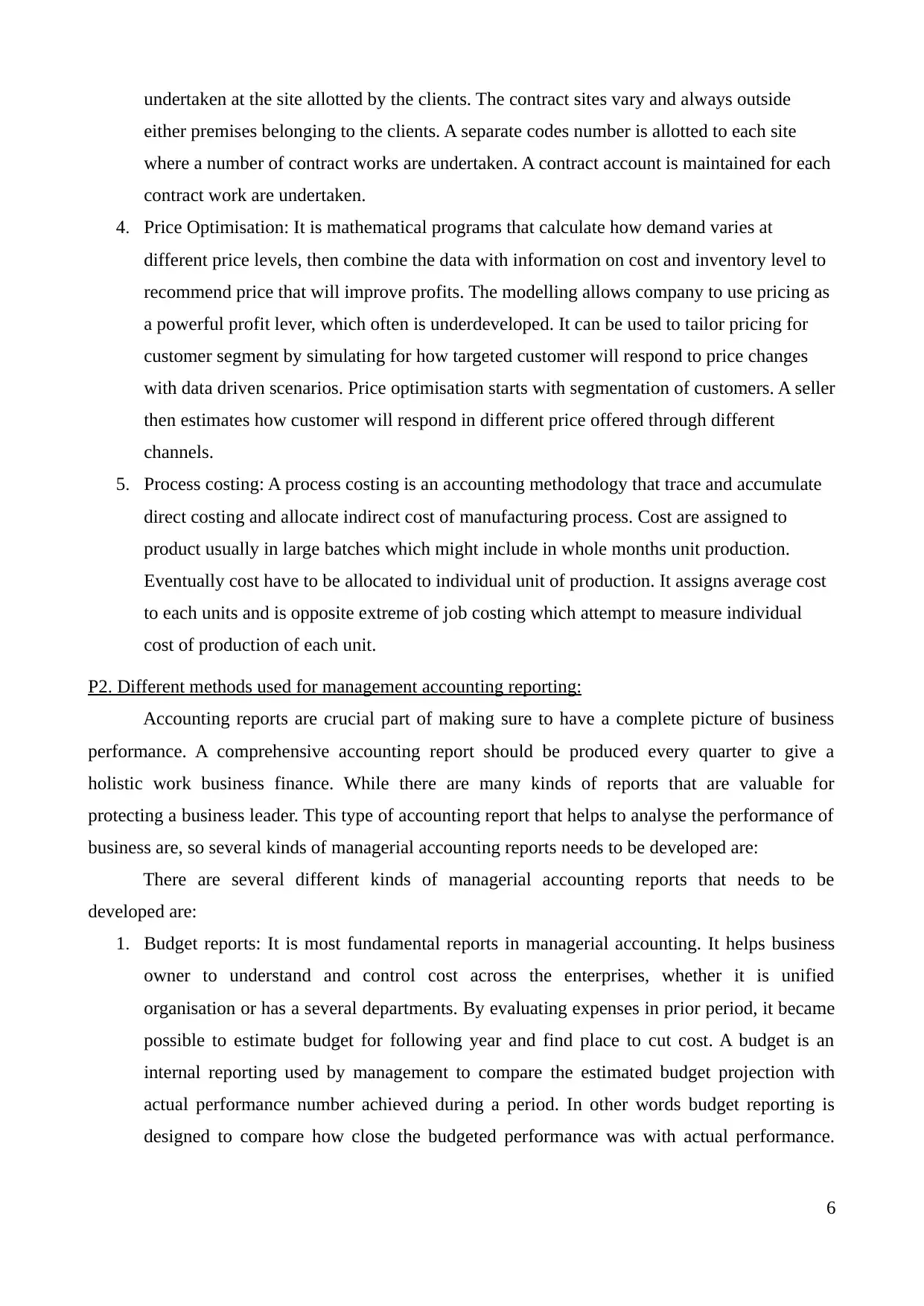
undertaken at the site allotted by the clients. The contract sites vary and always outside
either premises belonging to the clients. A separate codes number is allotted to each site
where a number of contract works are undertaken. A contract account is maintained for each
contract work are undertaken.
4. Price Optimisation: It is mathematical programs that calculate how demand varies at
different price levels, then combine the data with information on cost and inventory level to
recommend price that will improve profits. The modelling allows company to use pricing as
a powerful profit lever, which often is underdeveloped. It can be used to tailor pricing for
customer segment by simulating for how targeted customer will respond to price changes
with data driven scenarios. Price optimisation starts with segmentation of customers. A seller
then estimates how customer will respond in different price offered through different
channels.
5. Process costing: A process costing is an accounting methodology that trace and accumulate
direct costing and allocate indirect cost of manufacturing process. Cost are assigned to
product usually in large batches which might include in whole months unit production.
Eventually cost have to be allocated to individual unit of production. It assigns average cost
to each units and is opposite extreme of job costing which attempt to measure individual
cost of production of each unit.
P2. Different methods used for management accounting reporting:
Accounting reports are crucial part of making sure to have a complete picture of business
performance. A comprehensive accounting report should be produced every quarter to give a
holistic work business finance. While there are many kinds of reports that are valuable for
protecting a business leader. This type of accounting report that helps to analyse the performance of
business are, so several kinds of managerial accounting reports needs to be developed are:
There are several different kinds of managerial accounting reports that needs to be
developed are:
1. Budget reports: It is most fundamental reports in managerial accounting. It helps business
owner to understand and control cost across the enterprises, whether it is unified
organisation or has a several departments. By evaluating expenses in prior period, it became
possible to estimate budget for following year and find place to cut cost. A budget is an
internal reporting used by management to compare the estimated budget projection with
actual performance number achieved during a period. In other words budget reporting is
designed to compare how close the budgeted performance was with actual performance.
6
either premises belonging to the clients. A separate codes number is allotted to each site
where a number of contract works are undertaken. A contract account is maintained for each
contract work are undertaken.
4. Price Optimisation: It is mathematical programs that calculate how demand varies at
different price levels, then combine the data with information on cost and inventory level to
recommend price that will improve profits. The modelling allows company to use pricing as
a powerful profit lever, which often is underdeveloped. It can be used to tailor pricing for
customer segment by simulating for how targeted customer will respond to price changes
with data driven scenarios. Price optimisation starts with segmentation of customers. A seller
then estimates how customer will respond in different price offered through different
channels.
5. Process costing: A process costing is an accounting methodology that trace and accumulate
direct costing and allocate indirect cost of manufacturing process. Cost are assigned to
product usually in large batches which might include in whole months unit production.
Eventually cost have to be allocated to individual unit of production. It assigns average cost
to each units and is opposite extreme of job costing which attempt to measure individual
cost of production of each unit.
P2. Different methods used for management accounting reporting:
Accounting reports are crucial part of making sure to have a complete picture of business
performance. A comprehensive accounting report should be produced every quarter to give a
holistic work business finance. While there are many kinds of reports that are valuable for
protecting a business leader. This type of accounting report that helps to analyse the performance of
business are, so several kinds of managerial accounting reports needs to be developed are:
There are several different kinds of managerial accounting reports that needs to be
developed are:
1. Budget reports: It is most fundamental reports in managerial accounting. It helps business
owner to understand and control cost across the enterprises, whether it is unified
organisation or has a several departments. By evaluating expenses in prior period, it became
possible to estimate budget for following year and find place to cut cost. A budget is an
internal reporting used by management to compare the estimated budget projection with
actual performance number achieved during a period. In other words budget reporting is
designed to compare how close the budgeted performance was with actual performance.
6
⊘ This is a preview!⊘
Do you want full access?
Subscribe today to unlock all pages.

Trusted by 1+ million students worldwide
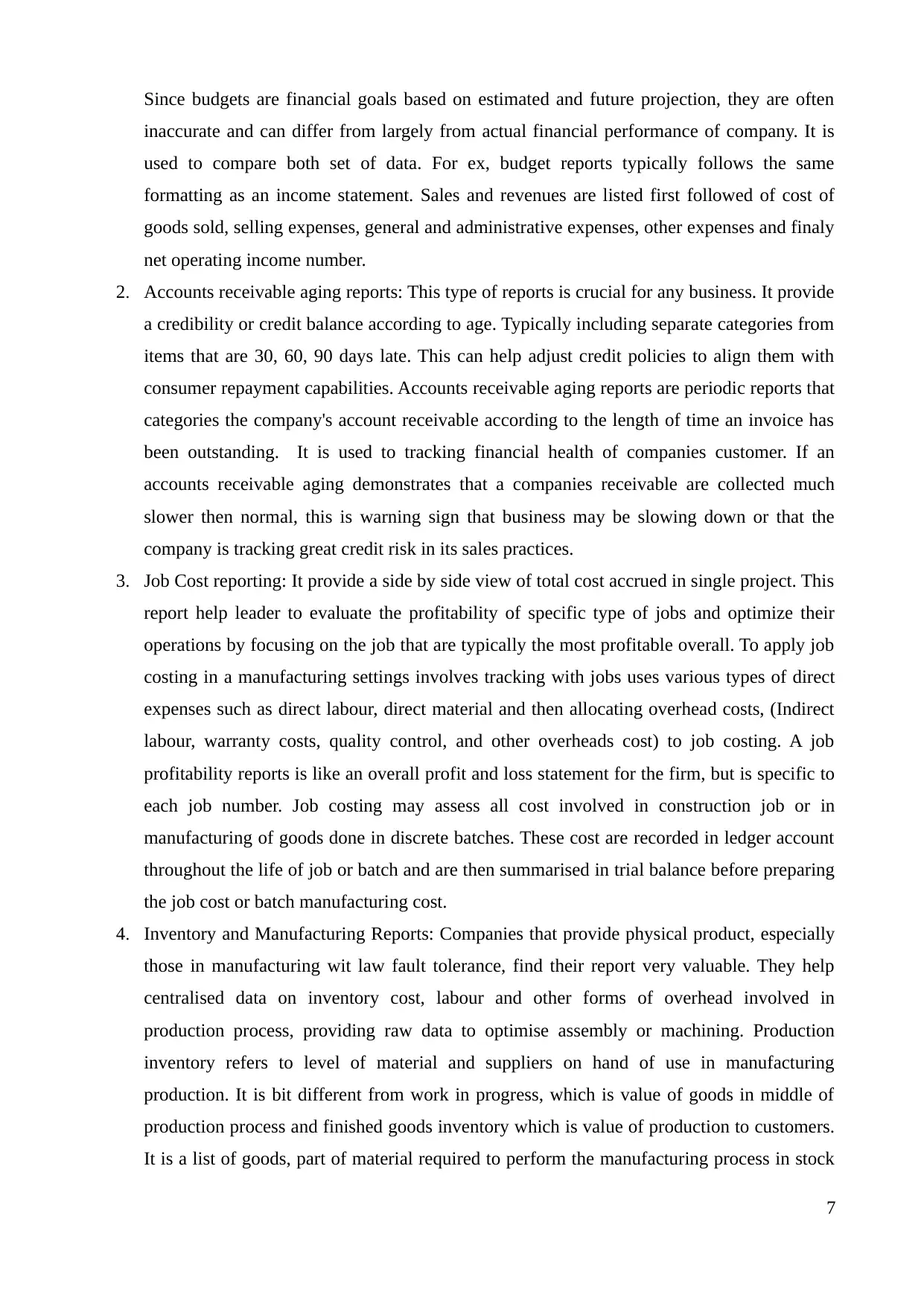
Since budgets are financial goals based on estimated and future projection, they are often
inaccurate and can differ from largely from actual financial performance of company. It is
used to compare both set of data. For ex, budget reports typically follows the same
formatting as an income statement. Sales and revenues are listed first followed of cost of
goods sold, selling expenses, general and administrative expenses, other expenses and finaly
net operating income number.
2. Accounts receivable aging reports: This type of reports is crucial for any business. It provide
a credibility or credit balance according to age. Typically including separate categories from
items that are 30, 60, 90 days late. This can help adjust credit policies to align them with
consumer repayment capabilities. Accounts receivable aging reports are periodic reports that
categories the company's account receivable according to the length of time an invoice has
been outstanding. It is used to tracking financial health of companies customer. If an
accounts receivable aging demonstrates that a companies receivable are collected much
slower then normal, this is warning sign that business may be slowing down or that the
company is tracking great credit risk in its sales practices.
3. Job Cost reporting: It provide a side by side view of total cost accrued in single project. This
report help leader to evaluate the profitability of specific type of jobs and optimize their
operations by focusing on the job that are typically the most profitable overall. To apply job
costing in a manufacturing settings involves tracking with jobs uses various types of direct
expenses such as direct labour, direct material and then allocating overhead costs, (Indirect
labour, warranty costs, quality control, and other overheads cost) to job costing. A job
profitability reports is like an overall profit and loss statement for the firm, but is specific to
each job number. Job costing may assess all cost involved in construction job or in
manufacturing of goods done in discrete batches. These cost are recorded in ledger account
throughout the life of job or batch and are then summarised in trial balance before preparing
the job cost or batch manufacturing cost.
4. Inventory and Manufacturing Reports: Companies that provide physical product, especially
those in manufacturing wit law fault tolerance, find their report very valuable. They help
centralised data on inventory cost, labour and other forms of overhead involved in
production process, providing raw data to optimise assembly or machining. Production
inventory refers to level of material and suppliers on hand of use in manufacturing
production. It is bit different from work in progress, which is value of goods in middle of
production process and finished goods inventory which is value of production to customers.
It is a list of goods, part of material required to perform the manufacturing process in stock
7
inaccurate and can differ from largely from actual financial performance of company. It is
used to compare both set of data. For ex, budget reports typically follows the same
formatting as an income statement. Sales and revenues are listed first followed of cost of
goods sold, selling expenses, general and administrative expenses, other expenses and finaly
net operating income number.
2. Accounts receivable aging reports: This type of reports is crucial for any business. It provide
a credibility or credit balance according to age. Typically including separate categories from
items that are 30, 60, 90 days late. This can help adjust credit policies to align them with
consumer repayment capabilities. Accounts receivable aging reports are periodic reports that
categories the company's account receivable according to the length of time an invoice has
been outstanding. It is used to tracking financial health of companies customer. If an
accounts receivable aging demonstrates that a companies receivable are collected much
slower then normal, this is warning sign that business may be slowing down or that the
company is tracking great credit risk in its sales practices.
3. Job Cost reporting: It provide a side by side view of total cost accrued in single project. This
report help leader to evaluate the profitability of specific type of jobs and optimize their
operations by focusing on the job that are typically the most profitable overall. To apply job
costing in a manufacturing settings involves tracking with jobs uses various types of direct
expenses such as direct labour, direct material and then allocating overhead costs, (Indirect
labour, warranty costs, quality control, and other overheads cost) to job costing. A job
profitability reports is like an overall profit and loss statement for the firm, but is specific to
each job number. Job costing may assess all cost involved in construction job or in
manufacturing of goods done in discrete batches. These cost are recorded in ledger account
throughout the life of job or batch and are then summarised in trial balance before preparing
the job cost or batch manufacturing cost.
4. Inventory and Manufacturing Reports: Companies that provide physical product, especially
those in manufacturing wit law fault tolerance, find their report very valuable. They help
centralised data on inventory cost, labour and other forms of overhead involved in
production process, providing raw data to optimise assembly or machining. Production
inventory refers to level of material and suppliers on hand of use in manufacturing
production. It is bit different from work in progress, which is value of goods in middle of
production process and finished goods inventory which is value of production to customers.
It is a list of goods, part of material required to perform the manufacturing process in stock
7
Paraphrase This Document
Need a fresh take? Get an instant paraphrase of this document with our AI Paraphraser
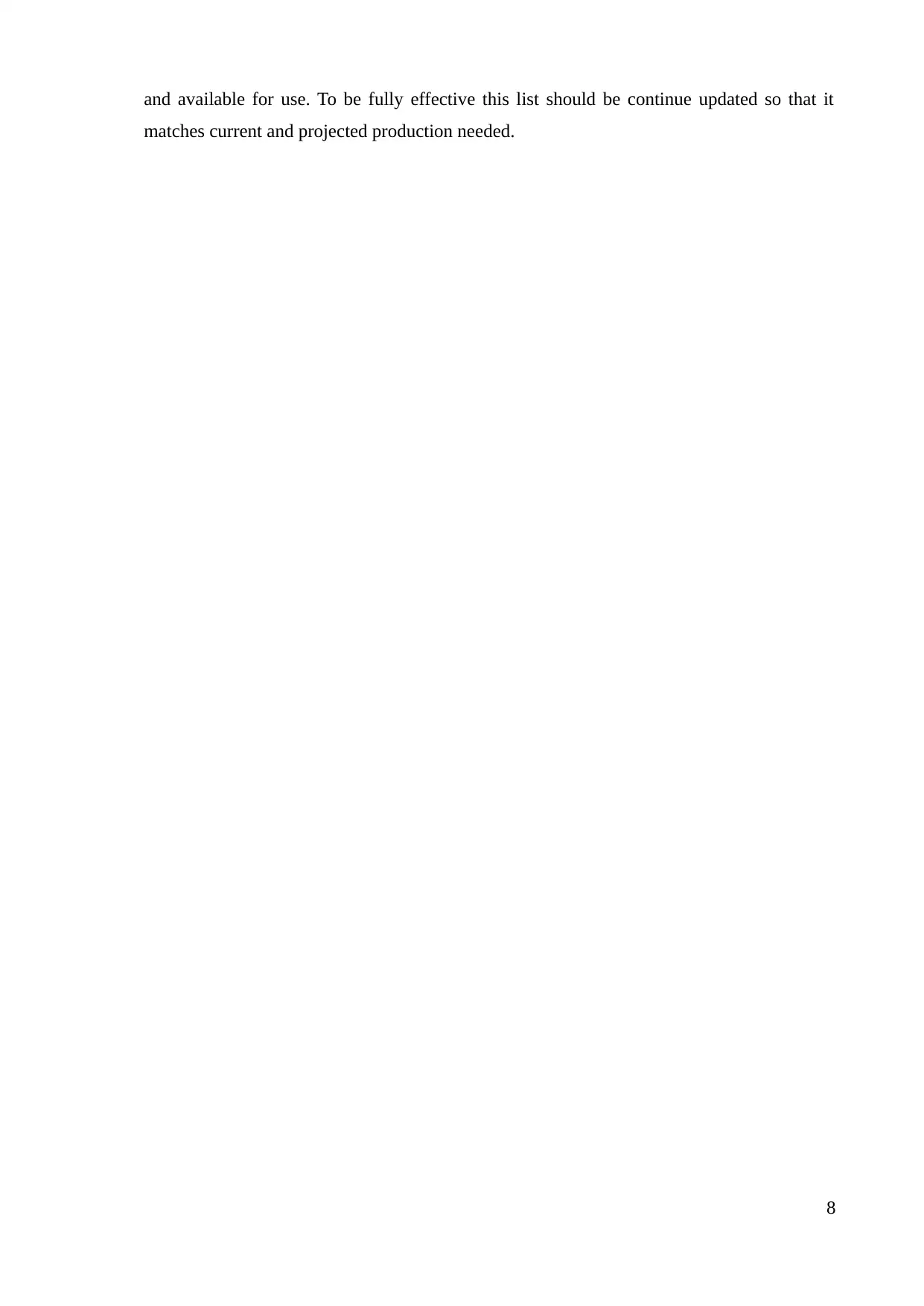
and available for use. To be fully effective this list should be continue updated so that it
matches current and projected production needed.
8
matches current and projected production needed.
8
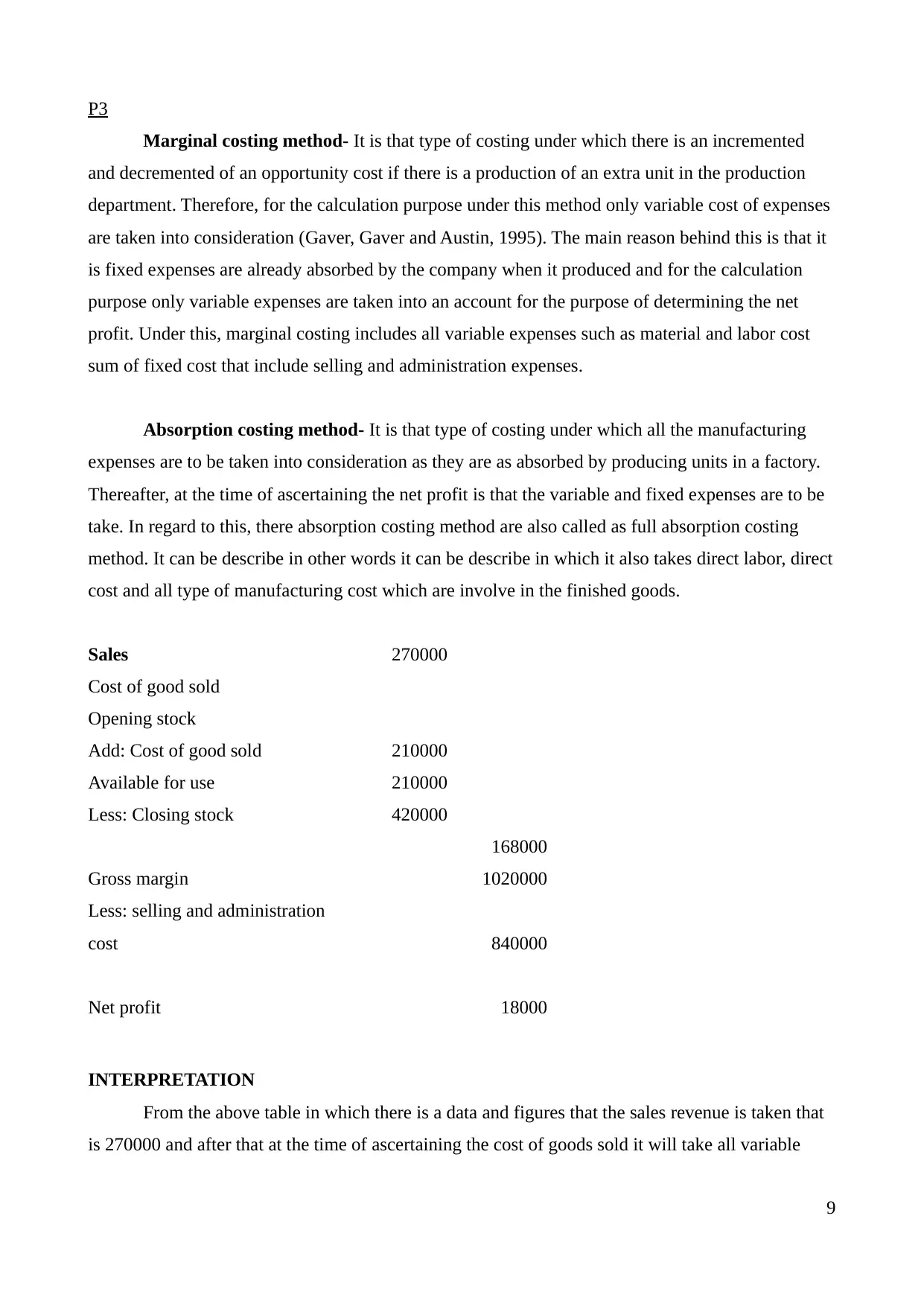
P3
Marginal costing method- It is that type of costing under which there is an incremented
and decremented of an opportunity cost if there is a production of an extra unit in the production
department. Therefore, for the calculation purpose under this method only variable cost of expenses
are taken into consideration (Gaver, Gaver and Austin, 1995). The main reason behind this is that it
is fixed expenses are already absorbed by the company when it produced and for the calculation
purpose only variable expenses are taken into an account for the purpose of determining the net
profit. Under this, marginal costing includes all variable expenses such as material and labor cost
sum of fixed cost that include selling and administration expenses.
Absorption costing method- It is that type of costing under which all the manufacturing
expenses are to be taken into consideration as they are as absorbed by producing units in a factory.
Thereafter, at the time of ascertaining the net profit is that the variable and fixed expenses are to be
take. In regard to this, there absorption costing method are also called as full absorption costing
method. It can be describe in other words it can be describe in which it also takes direct labor, direct
cost and all type of manufacturing cost which are involve in the finished goods.
Sales 270000
Cost of good sold
Opening stock
Add: Cost of good sold 210000
Available for use 210000
Less: Closing stock 420000
168000
Gross margin 1020000
Less: selling and administration
cost 840000
Net profit 18000
INTERPRETATION
From the above table in which there is a data and figures that the sales revenue is taken that
is 270000 and after that at the time of ascertaining the cost of goods sold it will take all variable
9
Marginal costing method- It is that type of costing under which there is an incremented
and decremented of an opportunity cost if there is a production of an extra unit in the production
department. Therefore, for the calculation purpose under this method only variable cost of expenses
are taken into consideration (Gaver, Gaver and Austin, 1995). The main reason behind this is that it
is fixed expenses are already absorbed by the company when it produced and for the calculation
purpose only variable expenses are taken into an account for the purpose of determining the net
profit. Under this, marginal costing includes all variable expenses such as material and labor cost
sum of fixed cost that include selling and administration expenses.
Absorption costing method- It is that type of costing under which all the manufacturing
expenses are to be taken into consideration as they are as absorbed by producing units in a factory.
Thereafter, at the time of ascertaining the net profit is that the variable and fixed expenses are to be
take. In regard to this, there absorption costing method are also called as full absorption costing
method. It can be describe in other words it can be describe in which it also takes direct labor, direct
cost and all type of manufacturing cost which are involve in the finished goods.
Sales 270000
Cost of good sold
Opening stock
Add: Cost of good sold 210000
Available for use 210000
Less: Closing stock 420000
168000
Gross margin 1020000
Less: selling and administration
cost 840000
Net profit 18000
INTERPRETATION
From the above table in which there is a data and figures that the sales revenue is taken that
is 270000 and after that at the time of ascertaining the cost of goods sold it will take all variable
9
⊘ This is a preview!⊘
Do you want full access?
Subscribe today to unlock all pages.

Trusted by 1+ million students worldwide
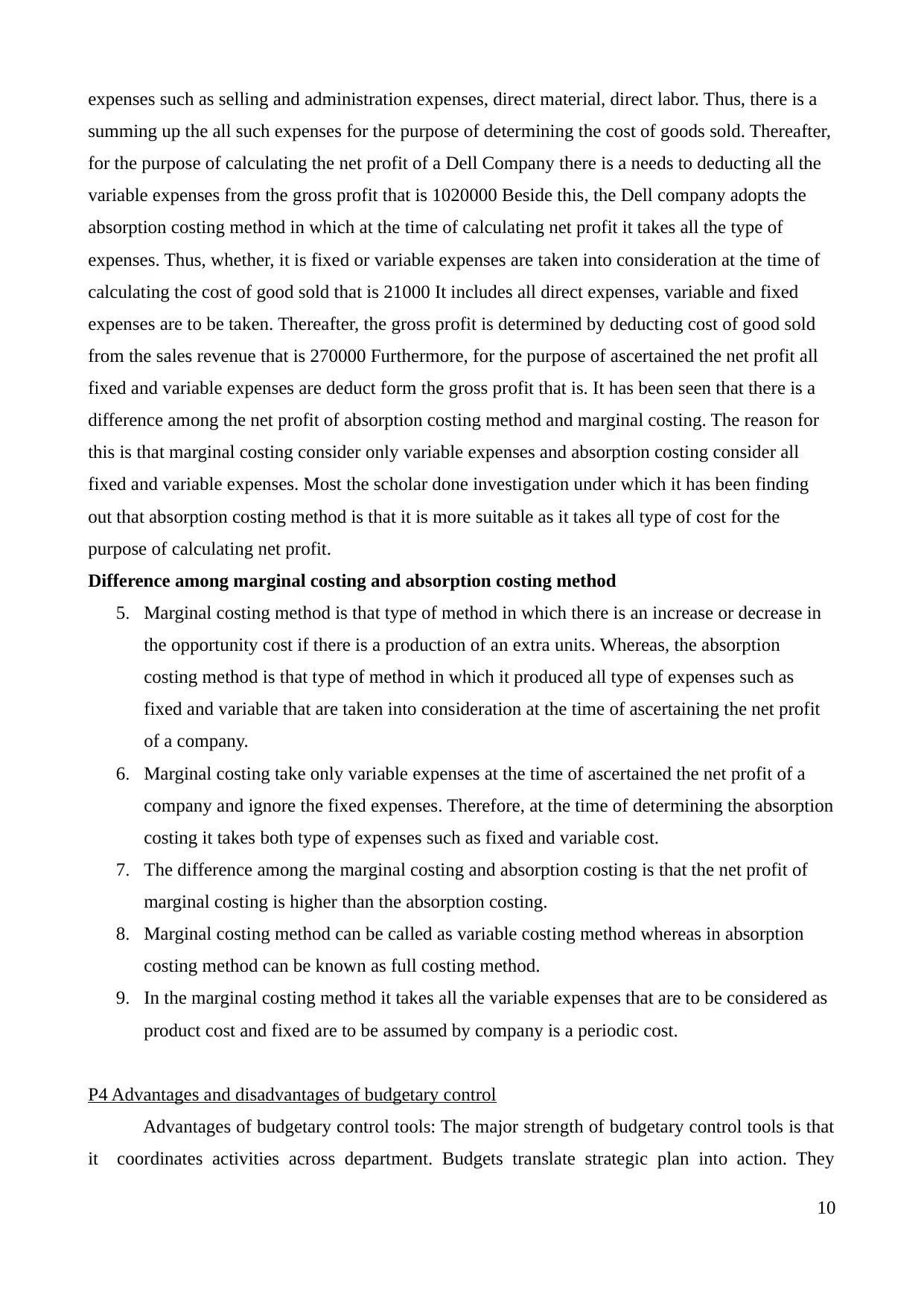
expenses such as selling and administration expenses, direct material, direct labor. Thus, there is a
summing up the all such expenses for the purpose of determining the cost of goods sold. Thereafter,
for the purpose of calculating the net profit of a Dell Company there is a needs to deducting all the
variable expenses from the gross profit that is 1020000 Beside this, the Dell company adopts the
absorption costing method in which at the time of calculating net profit it takes all the type of
expenses. Thus, whether, it is fixed or variable expenses are taken into consideration at the time of
calculating the cost of good sold that is 21000 It includes all direct expenses, variable and fixed
expenses are to be taken. Thereafter, the gross profit is determined by deducting cost of good sold
from the sales revenue that is 270000 Furthermore, for the purpose of ascertained the net profit all
fixed and variable expenses are deduct form the gross profit that is. It has been seen that there is a
difference among the net profit of absorption costing method and marginal costing. The reason for
this is that marginal costing consider only variable expenses and absorption costing consider all
fixed and variable expenses. Most the scholar done investigation under which it has been finding
out that absorption costing method is that it is more suitable as it takes all type of cost for the
purpose of calculating net profit.
Difference among marginal costing and absorption costing method
5. Marginal costing method is that type of method in which there is an increase or decrease in
the opportunity cost if there is a production of an extra units. Whereas, the absorption
costing method is that type of method in which it produced all type of expenses such as
fixed and variable that are taken into consideration at the time of ascertaining the net profit
of a company.
6. Marginal costing take only variable expenses at the time of ascertained the net profit of a
company and ignore the fixed expenses. Therefore, at the time of determining the absorption
costing it takes both type of expenses such as fixed and variable cost.
7. The difference among the marginal costing and absorption costing is that the net profit of
marginal costing is higher than the absorption costing.
8. Marginal costing method can be called as variable costing method whereas in absorption
costing method can be known as full costing method.
9. In the marginal costing method it takes all the variable expenses that are to be considered as
product cost and fixed are to be assumed by company is a periodic cost.
P4 Advantages and disadvantages of budgetary control
Advantages of budgetary control tools: The major strength of budgetary control tools is that
it coordinates activities across department. Budgets translate strategic plan into action. They
10
summing up the all such expenses for the purpose of determining the cost of goods sold. Thereafter,
for the purpose of calculating the net profit of a Dell Company there is a needs to deducting all the
variable expenses from the gross profit that is 1020000 Beside this, the Dell company adopts the
absorption costing method in which at the time of calculating net profit it takes all the type of
expenses. Thus, whether, it is fixed or variable expenses are taken into consideration at the time of
calculating the cost of good sold that is 21000 It includes all direct expenses, variable and fixed
expenses are to be taken. Thereafter, the gross profit is determined by deducting cost of good sold
from the sales revenue that is 270000 Furthermore, for the purpose of ascertained the net profit all
fixed and variable expenses are deduct form the gross profit that is. It has been seen that there is a
difference among the net profit of absorption costing method and marginal costing. The reason for
this is that marginal costing consider only variable expenses and absorption costing consider all
fixed and variable expenses. Most the scholar done investigation under which it has been finding
out that absorption costing method is that it is more suitable as it takes all type of cost for the
purpose of calculating net profit.
Difference among marginal costing and absorption costing method
5. Marginal costing method is that type of method in which there is an increase or decrease in
the opportunity cost if there is a production of an extra units. Whereas, the absorption
costing method is that type of method in which it produced all type of expenses such as
fixed and variable that are taken into consideration at the time of ascertaining the net profit
of a company.
6. Marginal costing take only variable expenses at the time of ascertained the net profit of a
company and ignore the fixed expenses. Therefore, at the time of determining the absorption
costing it takes both type of expenses such as fixed and variable cost.
7. The difference among the marginal costing and absorption costing is that the net profit of
marginal costing is higher than the absorption costing.
8. Marginal costing method can be called as variable costing method whereas in absorption
costing method can be known as full costing method.
9. In the marginal costing method it takes all the variable expenses that are to be considered as
product cost and fixed are to be assumed by company is a periodic cost.
P4 Advantages and disadvantages of budgetary control
Advantages of budgetary control tools: The major strength of budgetary control tools is that
it coordinates activities across department. Budgets translate strategic plan into action. They
10
Paraphrase This Document
Need a fresh take? Get an instant paraphrase of this document with our AI Paraphraser
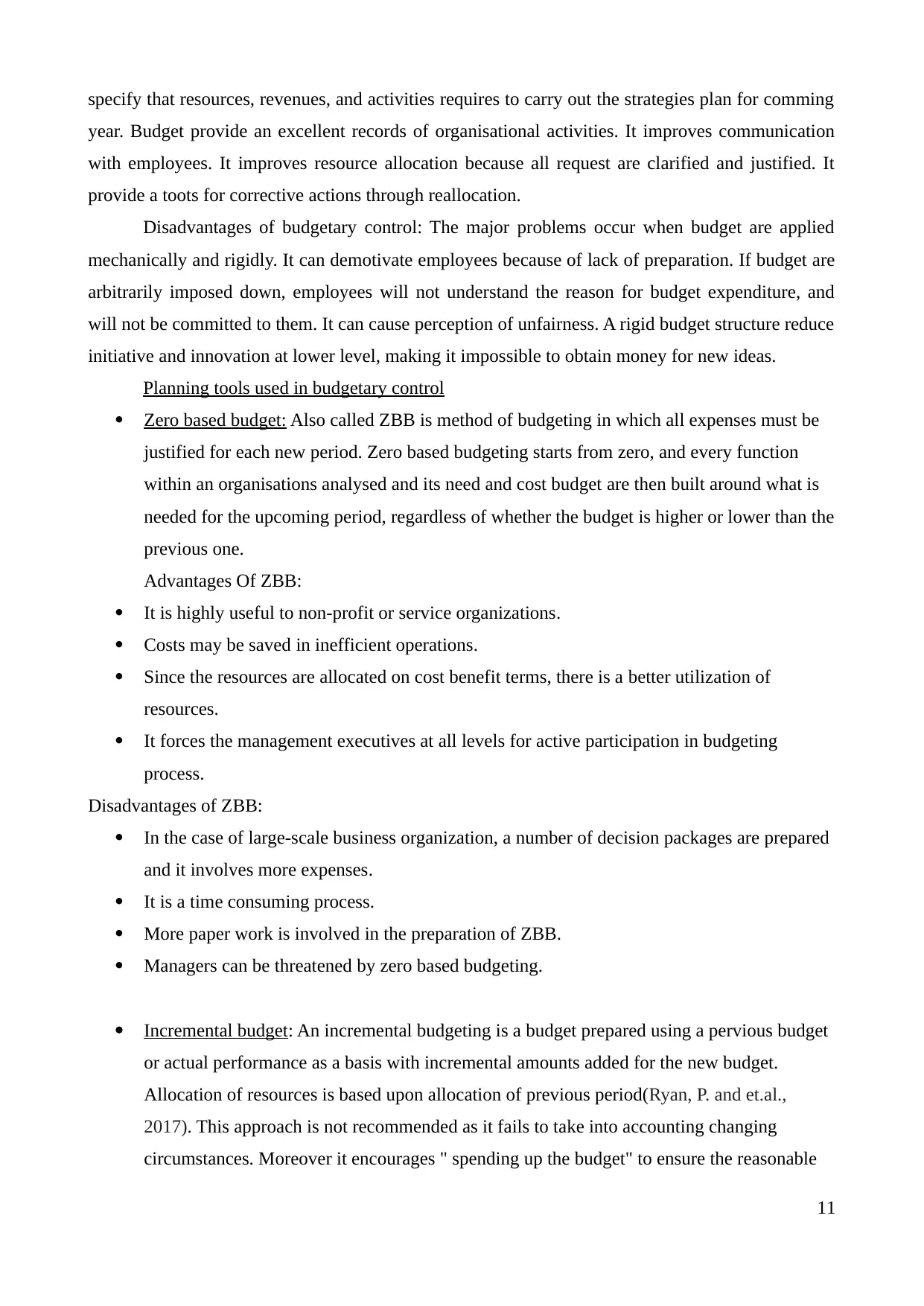
specify that resources, revenues, and activities requires to carry out the strategies plan for comming
year. Budget provide an excellent records of organisational activities. It improves communication
with employees. It improves resource allocation because all request are clarified and justified. It
provide a toots for corrective actions through reallocation.
Disadvantages of budgetary control: The major problems occur when budget are applied
mechanically and rigidly. It can demotivate employees because of lack of preparation. If budget are
arbitrarily imposed down, employees will not understand the reason for budget expenditure, and
will not be committed to them. It can cause perception of unfairness. A rigid budget structure reduce
initiative and innovation at lower level, making it impossible to obtain money for new ideas.
Planning tools used in budgetary control
Zero based budget: Also called ZBB is method of budgeting in which all expenses must be
justified for each new period. Zero based budgeting starts from zero, and every function
within an organisations analysed and its need and cost budget are then built around what is
needed for the upcoming period, regardless of whether the budget is higher or lower than the
previous one.
Advantages Of ZBB:
It is highly useful to non-profit or service organizations.
Costs may be saved in inefficient operations.
Since the resources are allocated on cost benefit terms, there is a better utilization of
resources.
It forces the management executives at all levels for active participation in budgeting
process.
Disadvantages of ZBB:
In the case of large-scale business organization, a number of decision packages are prepared
and it involves more expenses.
It is a time consuming process.
More paper work is involved in the preparation of ZBB.
Managers can be threatened by zero based budgeting.
Incremental budget: An incremental budgeting is a budget prepared using a pervious budget
or actual performance as a basis with incremental amounts added for the new budget.
Allocation of resources is based upon allocation of previous period(Ryan, P. and et.al.,
2017). This approach is not recommended as it fails to take into accounting changing
circumstances. Moreover it encourages " spending up the budget" to ensure the reasonable
11
year. Budget provide an excellent records of organisational activities. It improves communication
with employees. It improves resource allocation because all request are clarified and justified. It
provide a toots for corrective actions through reallocation.
Disadvantages of budgetary control: The major problems occur when budget are applied
mechanically and rigidly. It can demotivate employees because of lack of preparation. If budget are
arbitrarily imposed down, employees will not understand the reason for budget expenditure, and
will not be committed to them. It can cause perception of unfairness. A rigid budget structure reduce
initiative and innovation at lower level, making it impossible to obtain money for new ideas.
Planning tools used in budgetary control
Zero based budget: Also called ZBB is method of budgeting in which all expenses must be
justified for each new period. Zero based budgeting starts from zero, and every function
within an organisations analysed and its need and cost budget are then built around what is
needed for the upcoming period, regardless of whether the budget is higher or lower than the
previous one.
Advantages Of ZBB:
It is highly useful to non-profit or service organizations.
Costs may be saved in inefficient operations.
Since the resources are allocated on cost benefit terms, there is a better utilization of
resources.
It forces the management executives at all levels for active participation in budgeting
process.
Disadvantages of ZBB:
In the case of large-scale business organization, a number of decision packages are prepared
and it involves more expenses.
It is a time consuming process.
More paper work is involved in the preparation of ZBB.
Managers can be threatened by zero based budgeting.
Incremental budget: An incremental budgeting is a budget prepared using a pervious budget
or actual performance as a basis with incremental amounts added for the new budget.
Allocation of resources is based upon allocation of previous period(Ryan, P. and et.al.,
2017). This approach is not recommended as it fails to take into accounting changing
circumstances. Moreover it encourages " spending up the budget" to ensure the reasonable
11
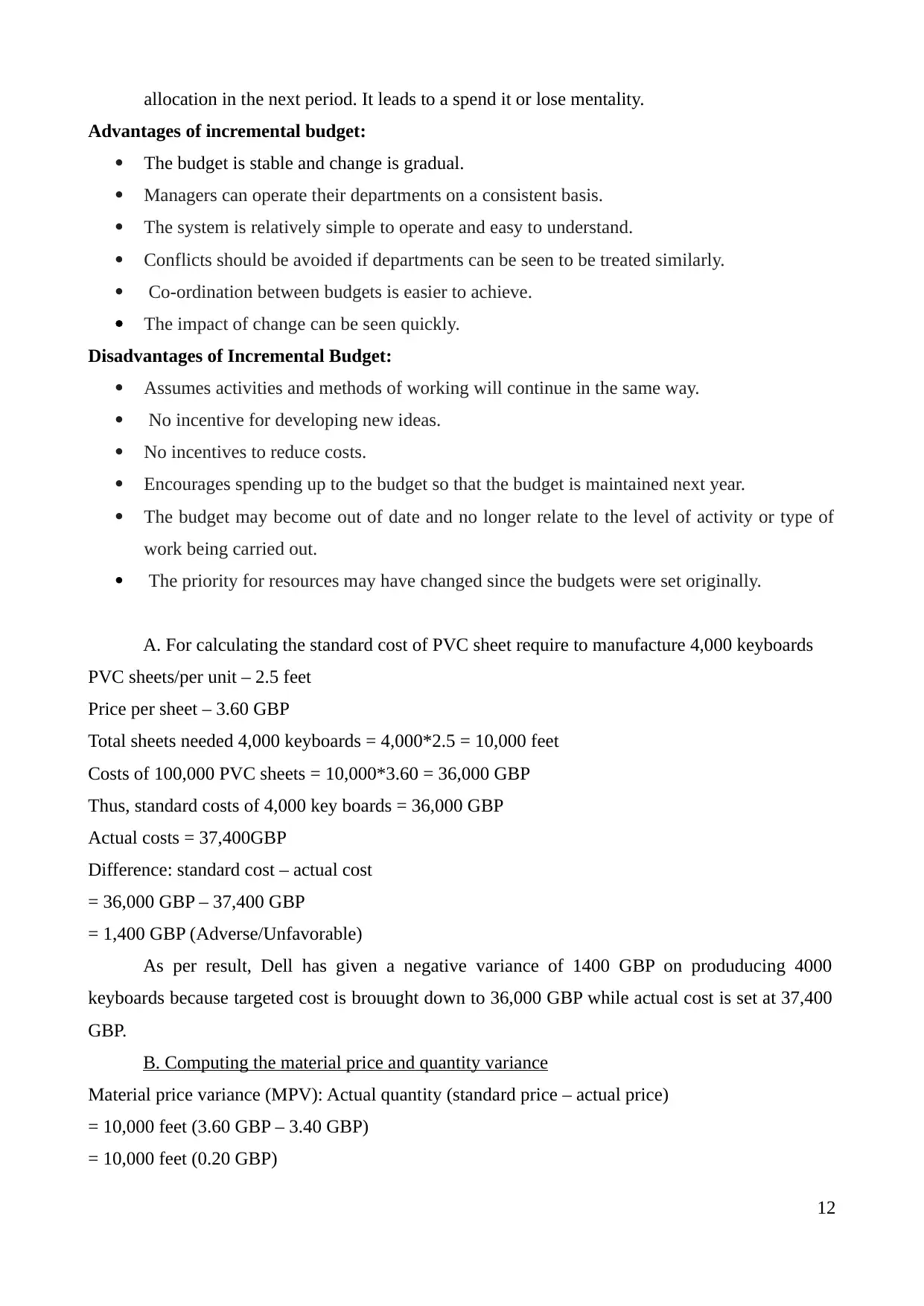
allocation in the next period. It leads to a spend it or lose mentality.
Advantages of incremental budget:
The budget is stable and change is gradual.
Managers can operate their departments on a consistent basis.
The system is relatively simple to operate and easy to understand.
Conflicts should be avoided if departments can be seen to be treated similarly.
Co-ordination between budgets is easier to achieve.
The impact of change can be seen quickly.
Disadvantages of Incremental Budget:
Assumes activities and methods of working will continue in the same way.
No incentive for developing new ideas.
No incentives to reduce costs.
Encourages spending up to the budget so that the budget is maintained next year.
The budget may become out of date and no longer relate to the level of activity or type of
work being carried out.
The priority for resources may have changed since the budgets were set originally.
A. For calculating the standard cost of PVC sheet require to manufacture 4,000 keyboards
PVC sheets/per unit – 2.5 feet
Price per sheet – 3.60 GBP
Total sheets needed 4,000 keyboards = 4,000*2.5 = 10,000 feet
Costs of 100,000 PVC sheets = 10,000*3.60 = 36,000 GBP
Thus, standard costs of 4,000 key boards = 36,000 GBP
Actual costs = 37,400GBP
Difference: standard cost – actual cost
= 36,000 GBP – 37,400 GBP
= 1,400 GBP (Adverse/Unfavorable)
As per result, Dell has given a negative variance of 1400 GBP on produducing 4000
keyboards because targeted cost is brouught down to 36,000 GBP while actual cost is set at 37,400
GBP.
B. Computing the material price and quantity variance
Material price variance (MPV): Actual quantity (standard price – actual price)
= 10,000 feet (3.60 GBP – 3.40 GBP)
= 10,000 feet (0.20 GBP)
12
Advantages of incremental budget:
The budget is stable and change is gradual.
Managers can operate their departments on a consistent basis.
The system is relatively simple to operate and easy to understand.
Conflicts should be avoided if departments can be seen to be treated similarly.
Co-ordination between budgets is easier to achieve.
The impact of change can be seen quickly.
Disadvantages of Incremental Budget:
Assumes activities and methods of working will continue in the same way.
No incentive for developing new ideas.
No incentives to reduce costs.
Encourages spending up to the budget so that the budget is maintained next year.
The budget may become out of date and no longer relate to the level of activity or type of
work being carried out.
The priority for resources may have changed since the budgets were set originally.
A. For calculating the standard cost of PVC sheet require to manufacture 4,000 keyboards
PVC sheets/per unit – 2.5 feet
Price per sheet – 3.60 GBP
Total sheets needed 4,000 keyboards = 4,000*2.5 = 10,000 feet
Costs of 100,000 PVC sheets = 10,000*3.60 = 36,000 GBP
Thus, standard costs of 4,000 key boards = 36,000 GBP
Actual costs = 37,400GBP
Difference: standard cost – actual cost
= 36,000 GBP – 37,400 GBP
= 1,400 GBP (Adverse/Unfavorable)
As per result, Dell has given a negative variance of 1400 GBP on produducing 4000
keyboards because targeted cost is brouught down to 36,000 GBP while actual cost is set at 37,400
GBP.
B. Computing the material price and quantity variance
Material price variance (MPV): Actual quantity (standard price – actual price)
= 10,000 feet (3.60 GBP – 3.40 GBP)
= 10,000 feet (0.20 GBP)
12
⊘ This is a preview!⊘
Do you want full access?
Subscribe today to unlock all pages.

Trusted by 1+ million students worldwide
1 out of 19
Related Documents
Your All-in-One AI-Powered Toolkit for Academic Success.
+13062052269
info@desklib.com
Available 24*7 on WhatsApp / Email
![[object Object]](/_next/static/media/star-bottom.7253800d.svg)
Unlock your academic potential
Copyright © 2020–2025 A2Z Services. All Rights Reserved. Developed and managed by ZUCOL.





